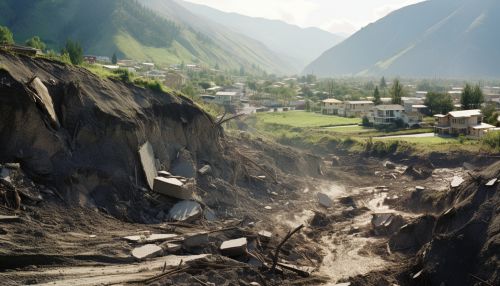Geological Hazards
Introduction
Geological hazards, also known as geohazards, are naturally occurring or human-induced conditions that pose a threat to the environment and human life. These hazards are associated with geological processes such as earthquakes, volcanic eruptions, landslides, and floods. Understanding geological hazards is crucial for disaster risk reduction and sustainable development.
Types of Geological Hazards
There are several types of geological hazards, each with unique characteristics and impacts. These include:
Earthquakes
Earthquakes are sudden shaking or trembling of the ground caused by the movement of tectonic plates beneath the Earth's surface. They can lead to significant damage to infrastructure, loss of life, and other secondary hazards such as tsunamis and landslides.
Volcanic Eruptions
Volcanic eruptions occur when there is a sudden release of magma, gas, and other materials from beneath the Earth's surface. They can result in the destruction of habitats, loss of life, and long-term changes to the climate.
Landslides
Landslides involve the movement of rock, earth, or debris down a slope. They can be triggered by natural events such as heavy rainfall, earthquakes, or human activities like deforestation and mining.
Floods
Floods are an overflow of water onto normally dry land. They can be caused by excessive rainfall, melting of ice, or dam failure. Floods can lead to loss of life, damage to property, and disruption of economic activities.


Causes of Geological Hazards
Geological hazards are caused by a variety of factors, both natural and human-induced. These include:
Tectonic Activity
Tectonic activity refers to the movement and interaction of the Earth's tectonic plates. This can lead to earthquakes, volcanic eruptions, and tsunamis.
Weather and Climate
Extreme weather conditions and changes in climate can lead to geological hazards such as floods and landslides. For example, heavy rainfall can saturate the ground, causing it to become unstable and prone to landslides.
Human Activities
Human activities such as deforestation, mining, and construction can also contribute to geological hazards. These activities can destabilize the land, leading to landslides and soil erosion.
Impacts of Geological Hazards
The impacts of geological hazards can be devastating, affecting both the natural environment and human societies. These impacts include:
Loss of Life
One of the most immediate and tragic impacts of geological hazards is the loss of human life. Earthquakes, volcanic eruptions, and landslides can bury or crush people, while floods can drown them.
Damage to Infrastructure
Geological hazards can cause significant damage to infrastructure, including homes, roads, and utilities. This can disrupt essential services and economic activities, leading to long-term social and economic impacts.
Environmental Damage
Geological hazards can also cause severe damage to the environment. For example, volcanic eruptions can release toxic gases and ash that can harm or kill plants and animals.
Mitigation of Geological Hazards
Mitigating the effects of geological hazards involves a combination of planning, preparation, and response. This includes:
Risk Assessment
Risk assessment involves identifying potential hazards, assessing the vulnerability of communities, and estimating the potential impacts. This information can be used to develop strategies for reducing risk.
Early Warning Systems
Early warning systems can provide advance notice of a potential hazard, giving people time to evacuate or take other protective measures.
Infrastructure Design
Infrastructure can be designed to withstand geological hazards. For example, buildings can be constructed to withstand earthquakes, and flood defenses can be built to protect against floods.
